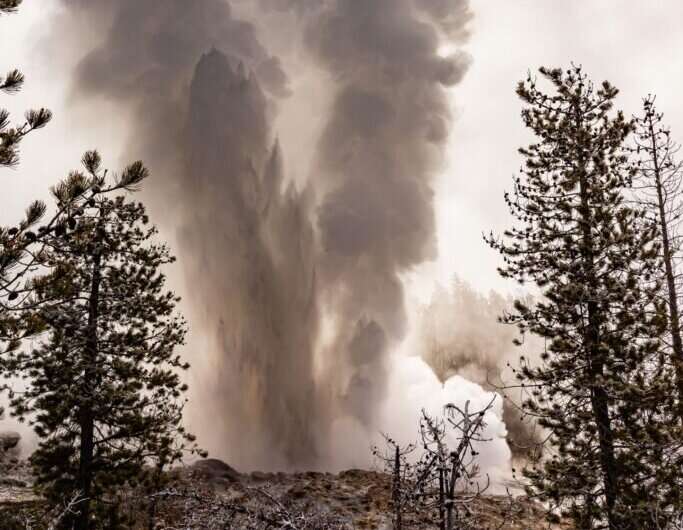
Steamboat Geyser erupts and sends a jet of water and steam above the treeline. This hot mineral water can harm the trees that grow within the geyser’s spray distance. Source: Mara H. Reed
Yellowstone’s Steamboat Geyser has a decades-long dry spell caused by a history of drought, a new study has found. As global temperatures rise, the American West is expected to become drier. A persistent drought in this region could slow down, and possibly stop, Yellowstone National Park’s famous geyser eruptions, researchers say.
“Even small changes in rainfall can affect the interval between eruptions,” explained Shaul Hurwitz, a hydrologist at the United States Geological Survey (USGS) who led the study. “So more water means more frequent eruptions, while less water means less frequent eruptions.”
Geysers require very specific conditions to form, including a water source, heat supply, and proper geologic plumbing. Environmental conditions such as drought can tip the balance and cause geysers to go dormant. The new study, published in Geochemistry, Geophysics, Geosystemsused partially mineralized wood at Steamboat Geyser to reconstruct past periods of inactivity and determine what caused the geyser to dry up.
Steamboat, the world’s tallest active geyser, can spray water up to about 115 meters (377 feet) into the air for 90 minutes at a time. Unlike the park’s Old Faithful Geyser, Steamboat doesn’t erupt on a predictable schedule, with eruption intervals ranging from three days to 50 years, according to the USGS. Now, researchers are looking to understand why geyser activity has waxed and waned over the centuries.
When Steamboat erupts, the geyser’s heated water sprays nearby trees with silica, a mineral that prevents decay. This silica fog slowly covers the trees, eventually killing them while preserving the tree’s structure. As a result, the dead trees surrounding the geyser can be preserved for centuries longer than usual, making it a useful tool for studying geyser history.
“In Yellowstone, you rarely find any trees, even dead trees, that are more than 300 years old because fungi and other bacteria rot them,” Hurwitz said. “Silica essentially protects the tree from fungi. For us, this is an advantage because if they were not silicified we would not have trees until now.”
Lodgepole pines make up almost all of Yellowstone’s forest. However, they have an average life span of only 150 to 200 years. Hurwitz and his team took advantage of this preservation process and collected silicate wood samples from within 14 meters (46 feet) of the geyser’s vent. Through radiocarbon dating, they found that the wood samples were collected in three time periods: the late 15th century, the middle of the 17th century and the late 18th century.
“The water that flows from the geyser is rich in silica, and when the silica flows it blocks the channels that allow trees to breathe, photosynthesize and grow,” Hurwitz explained. “For us, this shows that if the trees grow right next to the mound there will be no explosions.”
Hurwitz and his team matched the three periods of tree growth around the geyser to the climate records of the region and found that droughts occurred at the same time as the trees grew. These environmental conditions likely reduced the local water supply, preventing Steamboat from erupting and allowing trees to grow—but the geyser did not remain dormant for long.
“In the case of Steamboat, we found no remains of silicified wood with more than 10 or 20 annual rings, which suggests to us that trees never grew around the area,” Hurwitz said. “Therefore, there is not a long period of many decades or centuries with continuous growth.”
But as global temperatures rise, prolonged drought in the American West may reduce Yellowstone’s geyser activity.
“As we move towards a predicted warmer and drier climate in the 21st century, we can expect to see geysers behave differently in terms of the distance between their eruptions – less frequent eruptions, and some of them may become extinct,” said Hurwitz.
Famous geysers like Old Faithful may become less “faithful” in their eruption schedules as their water supply dwindles. According to Hurwitz, these changes in geyser activity could have long-term implications for how Yellowstone National Park manages visitation in general.
More information:
Shaul Hurwitz et al, The Relationship Between Decadal Droughts and Steamboat Geyser Eruptions in Yellowstone National Park, USA, Geochemistry, Geophysics, Geosystems (2023). DOI: 10.1029/2023GC010988
Provided by the American Geophysical Union
Citation: Petrified trees reveal Yellowstone geyser’s ongoing battle with drought (2023, July 25) retrieved July 25, 2023 from https://phys.org/news/2023-07-petrified-trees-reveal-yellowstone-geyser.html
This document is subject to copyright. Except for any fair dealing for the purpose of private study or research, no part may be reproduced without written permission. Content is provided for informational purposes only.
